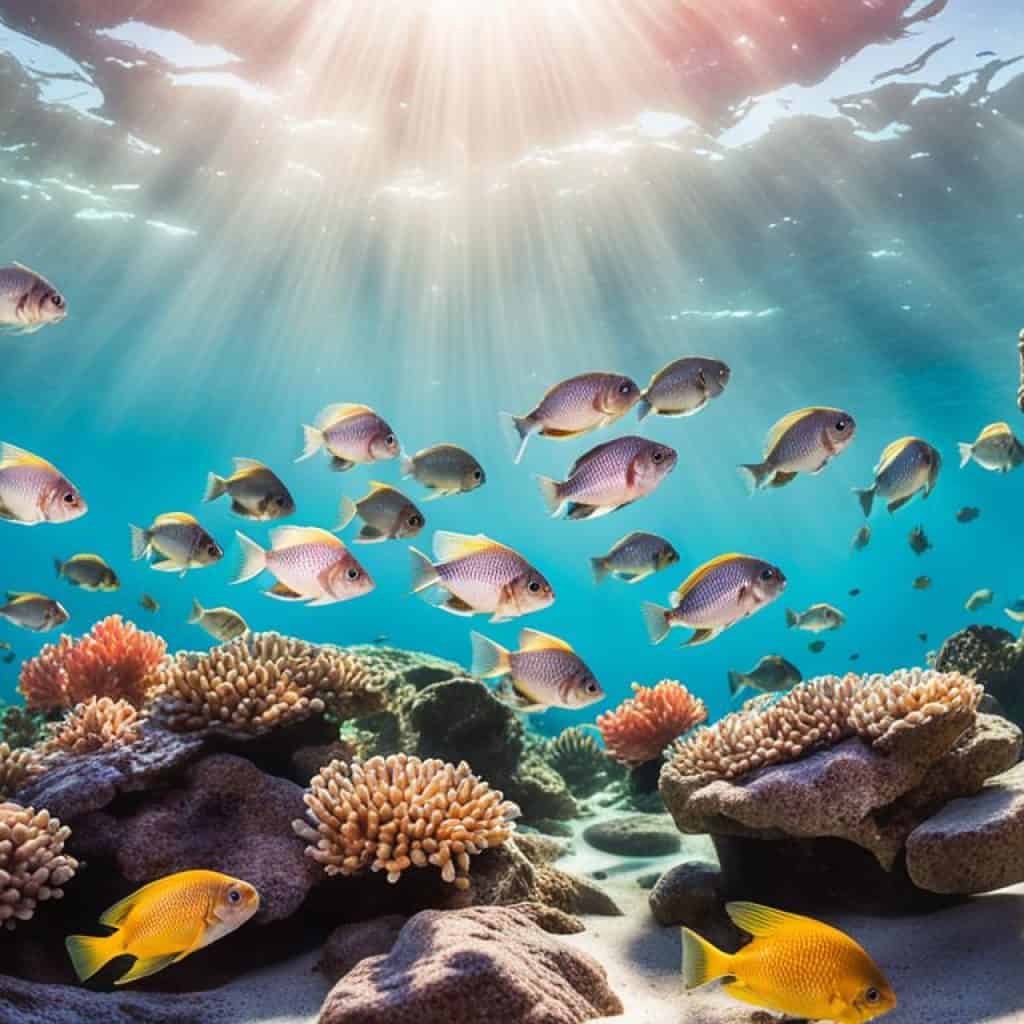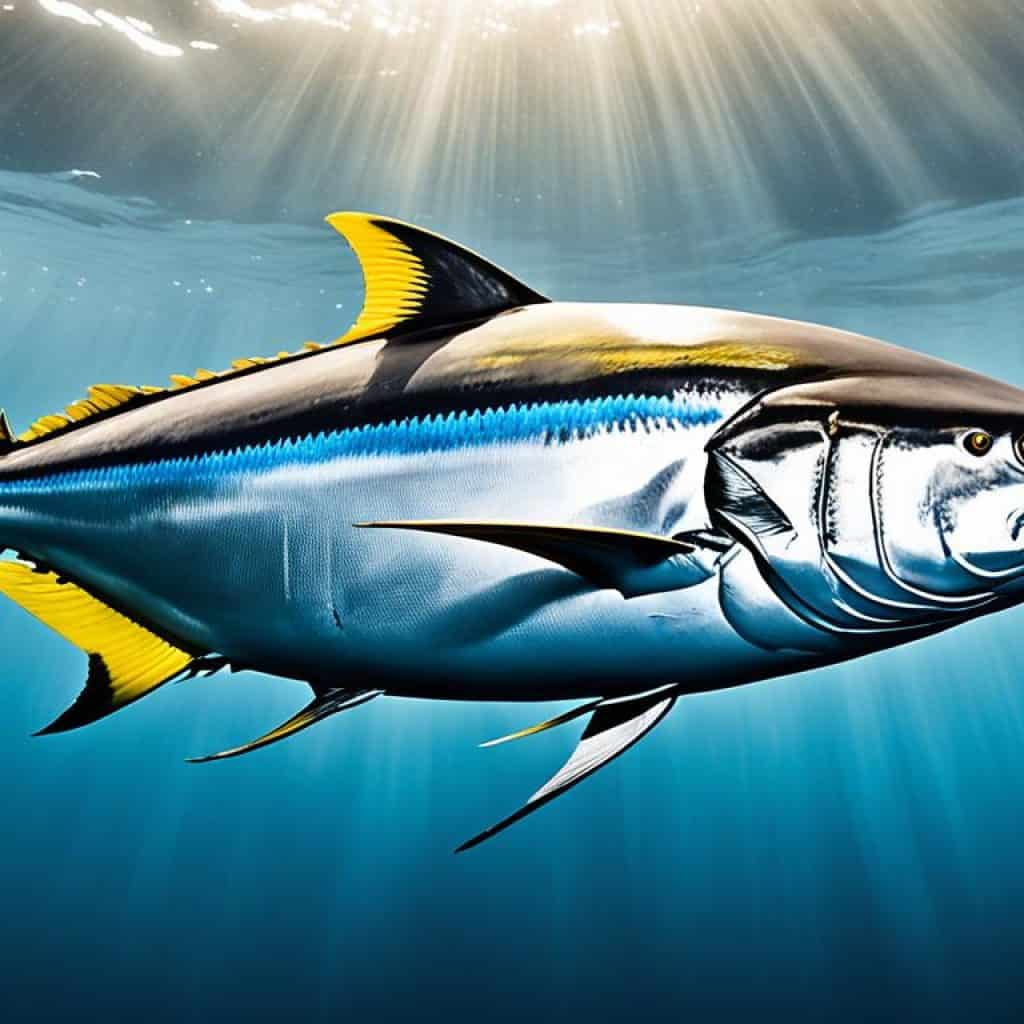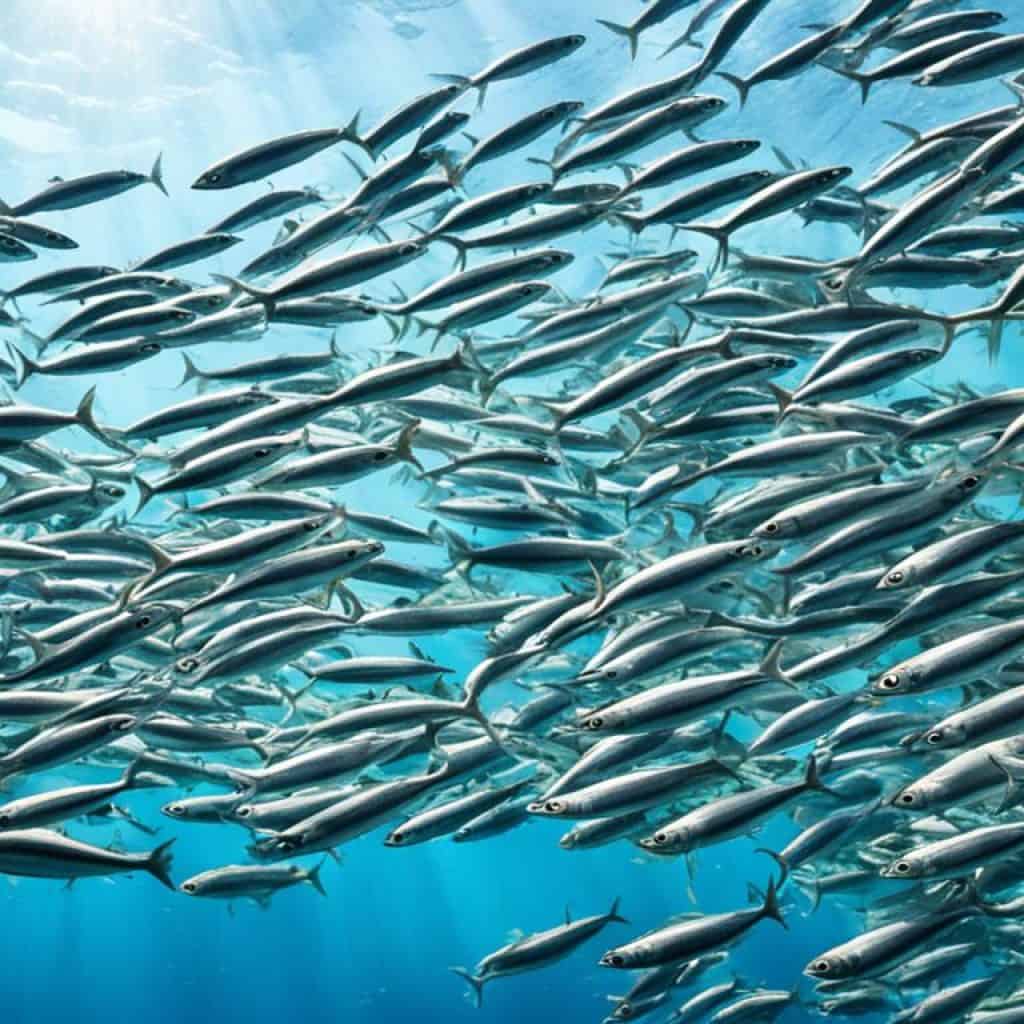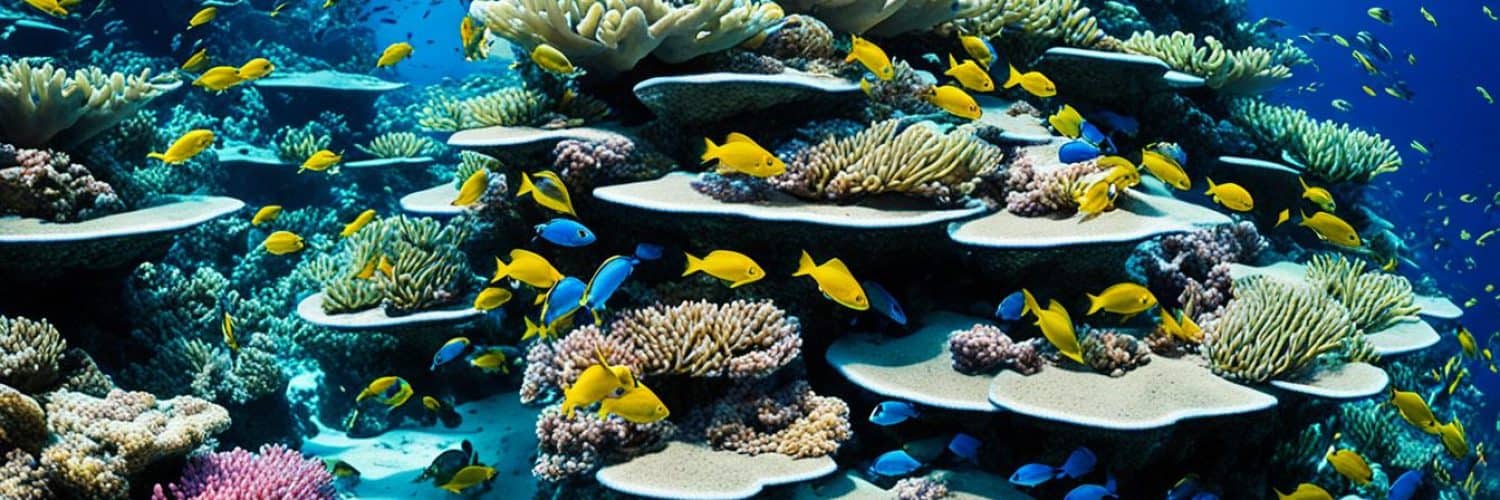The Philippines, an archipelago of over 7,000 islands, is home to a diverse array of fish species. These waters are teeming with life, offering a paradise for fish enthusiasts and a haven for seafood lovers. But have you ever wondered about the different kinds of fish that thrive in the Philippine waters? From popular varieties to hidden gems, the Filipino fish species are a testament to the country’s rich marine biodiversity.
Key Takeaways:
- The Philippines is home to a wide variety of fish species due to its rich marine biodiversity.
- Fish enthusiasts and seafood lovers can discover popular and lesser-known varieties in the Philippine waters.
- Understanding the diverse fish species in the Philippines contributes to the appreciation of the country’s culinary traditions and economic well-being.
- Conservation efforts are crucial in preserving the marine ecosystems and fish populations for future generations.
- By promoting sustainable fishing practices and responsible resource management, we can protect and sustain the diverse fish species found in the Philippines.
Bangus (Milkfish)
Bangus, or milkfish, is a cherished fish in Filipino cuisine and culture. It holds the title of being the national fish of the Philippines and is widely available in the Philippine market. One of the reasons for its popularity lies in its delicate and tender meat, which makes it a versatile ingredient in various dishes. Whether it’s grilled to perfection, fried for a crispy texture, or used in sinigang, a savory tamarind-based soup, Bangus remains a staple on Filipino dining tables.
What sets Bangus apart is its adaptability, thriving in both fresh and brackish waters. This characteristic makes it abundantly available throughout the archipelago, making it a common find in the Philippine market. Its significance in Filipino cuisine and its accessibility have cemented Bangus’ position as a familiar and beloved fish among the Filipino people.
| Key Features | Dishes | Culinary Uses |
|---|---|---|
| Delicate and tender meat |
|
|
Tilapia
Tilapia is an incredibly popular fish in the Philippine market, valued for its mild taste and lean white flesh. It has become a common feature in the local aquaculture industry due to its rapid growth and ease of cultivation. Whether steamed, fried, or grilled, Tilapia offers a versatile culinary experience. Accompanied by flavorful sauces and spices, this fish never fails to delight the taste buds.

Tilapia’s mild flavor and firm texture make it a versatile ingredient in various Filipino dishes. It pairs well with tangy sauces, aromatic herbs, and zesty spices, allowing for a range of flavor profiles. The aquaculture industry has flourished thanks to the popularity of Tilapia, as it provides a sustainable and consistent supply of this beloved fish. With its delectable taste and widespread availability, Tilapia continues to be a favorite choice among locals and visitors alike.
Lapu-Lapu (Leopard Coral Grouper)
Lapu-Lapu, also known as Leopard Coral Grouper, is a highly sought-after fish in the Philippines. It is renowned for its succulent and flaky flesh, which makes it a favorite among seafood enthusiasts and discerning diners. This large predatory fish species holds a significant place in Filipino culinary traditions and is often featured in high-end restaurant menus.
With its distinct leopard-like skin pattern, Lapu-Lapu stands out both visually and gastronomically. Its meat is prized for its delicate texture and rich flavor, making it a versatile ingredient for various cooking methods. Whether steamed, grilled, or fried, Lapu-Lapu delivers a delectable dining experience.
Tambakol (Yellowfin Tuna)
Tambakol, also known as yellowfin tuna, holds a prominent position as one of the commercially important fishes in the market. Its streamlined body and vibrant yellow fin make it easily recognizable among other species. However, it is the firm and flavorful meat that truly sets Tambakol apart.
This highly sought-after fish is in high demand both locally and internationally. Its versatility makes it a favorite choice for various culinary preparations. Whether grilled to perfection, fried to a crisp, or featured in traditional Filipino dishes like ginataan and paksiw, Tambakol consistently delivers a delightful dining experience.
Known for its succulent texture and robust flavor profile, Tambakol has become a staple in seafood markets and restaurants around the world. Its firm meat retains its shape even when exposed to high temperatures, making it ideal for searing and grilling. This characteristic creates a satisfying texture that keeps customers coming back for more.
“Tambakol is the epitome of a premium seafood delicacy. Its firmness and rich taste make it a favorite among seafood enthusiasts and chefs alike.”
With a growing awareness of the importance of sustainable fishing practices, efforts are being made to regulate the fishing of yellowfin tuna. Adhering to responsible and ethical fishing methods ensures the preservation of this commercially important fish for generations to come. By supporting sustainable initiatives and responsible sourcing, consumers can contribute to the long-term viability of Tambakol and the delicate balance of our marine ecosystems.
“Tambakol’s firm and flavorful meat offers a unique seafood experience. Celebrate the taste of this commercially important yellowfin tuna.”

| Benefits of Tambakol (Yellowfin Tuna) | Preparation Methods |
|---|---|
|
|
Maya-Maya (Red Snapper)
Maya-Maya, or red snapper, is a prized fish with striking red scales and a reputation for its sweet and tender meat. This highly sought-after fish thrives in coral reefs and rocky areas, making it a favorite catch among local fishermen in the Philippines.
“Maya-Maya is known for its exquisite flavor and delicate texture. Its sweet and tender meat lends itself well to a variety of culinary preparations, making it a versatile ingredient in Filipino cuisine.”
One popular way to cook Maya-Maya is by steaming it with ginger and soy sauce, allowing the natural flavors of this prized fish to shine through. It can also be fried to perfection, creating a crisp and flavorful exterior while maintaining its moist and succulent interior. Not to mention, Maya-Maya is often the star of a delicious roasted recipe, which further enhances its unique taste and texture.
With its popularity in Filipino cuisine, efforts are being made to manage the Maya-Maya population and promote its sustainability. It is important to ensure responsible fishing practices and conservation efforts to maintain the abundance of this treasured fish for future generations to enjoy.
Alumahan (Long-jawed Mackerel)
Alumahan, or long-jawed mackerel, is a highly migratory species commonly found in the waters of the Philippines. With its elongated body and distinct pattern of stripes, it is easily distinguishable from other fish.
What makes Alumahan special is its prized richness. The meat of this fish is highly sought after for its delectable flavor. It is often smoked or grilled to further enhance its natural richness and taste.
“Alumahan is a true gem of the Philippine waters, loved by both locals and seafood enthusiasts worldwide. Its rich flavor and tender texture make it a standout ingredient in various culinary creations.” – Chef Juan Dela Cruz
The highly migratory nature of Alumahan allows it to be plentifully available in different parts of the Philippines, making it accessible to many seafood lovers. Whether enjoyed grilled, smoked, or incorporated into sumptuous dishes, Alumahan continues to be a prized choice for its richness and unique taste.
Discover the visual appeal of Alumahan:
| Nutritional Information | Value per 100g |
|---|---|
| Calories | 142 |
| Protein | 20.3g |
| Fat | 6.2g |
| Carbohydrates | 0g |
| Omega-3 Fatty Acids | 1,536mg |
Source: Philippine Bureau of Fisheries and Aquatic Resources
Galunggong (Round Scad)
Galunggong is a common fish in the Philippines that is widely recognized for its affordability and availability. This silver-colored fish has become a staple protein source for many Filipinos, particularly those from lower-income households. The Galunggong is known for its versatility, making it suitable for various cooking methods. One popular way to prepare Galunggong is by lightly salting and frying it, creating a simple yet satisfying dish with a crispy texture. Additionally, Galunggong can also be used in paksiw, a traditional Filipino dish where the fish is simmered in vinegar, garlic, and spices. Its abundant supply and budget-friendly nature make Galunggong a beloved choice among Filipino households looking for an affordable and nutritious meal option.
Bisugo (Threadfin Bream)
Bisugo, also known as Threadfin Bream, is a popular fish in the Philippines valued for its delicate and sweet-flavored meat. This species is a favorite among seafood enthusiasts and can be found in sandy or muddy bottoms near the shore. With its tender and flavorful flesh, Bisugo is often prepared whole and cooked in a comforting broth with vegetables, resulting in a dish called “paksiw na bisugo.”
To ensure the continued abundance of Bisugo populations, monitoring efforts are in place to protect their numbers and sustain their availability. As a result, seafood lovers can enjoy the delicate and sweet taste of Bisugo for years to come.
“The delicate and sweet-flavored meat of Bisugo makes it a beloved choice among fish enthusiasts in the Philippines.”
Dilis (Anchovy)
Dilis, or anchovy, may be small in size, but it plays a significant role in Filipino cuisine. These tiny silver fish are usually dried and salted, becoming a flavorful and crunchy accompaniment to various dishes.
Dilis is also a vital component of the marine food chain, serving as a critical food source for larger predatory fish and birds. Its abundance supports the sustainability of higher levels of the marine food web, ensuring balance and maintaining the overall health of marine ecosystems.
These small, oily fish contain essential nutrients such as omega-3 fatty acids, calcium, and protein, making them a nutritious choice. Their distinct umami flavor adds depth to sauces, dressings, and even pizza toppings. Anchovies are also widely used in Filipino dishes such as pinakbet and bagoong, enhancing the overall taste profile and aroma.
“Anchovies are the unsung heroes of countless dishes, adding a burst of savory goodness to every bite. Their contribution to the marine food chain is equally invaluable, sustaining the biodiversity of our oceans. Let’s celebrate the anchovy, a small but mighty fish!”

Tulingan (Bullet Tuna)
Tulingan, or bullet tuna, is a close relative of the larger Tambakol. This fish gets its name from its bullet-like shape and impressive speed in the water. It is a popular catch for local fishermen due to its relatively fast growth and abundance.
Known for its firm and flavorful meat, Tulingan is commonly grilled or used in the preparation of the popular Filipino dish “paksiw na tulingan.” This delectable dish involves cooking the fish in a mixture of vinegar, garlic, and spices, resulting in a flavorful and savory meal.
Local fishermen consider Tulingan an important catch as it provides sustenance and livelihood for their communities. Its availability and versatility in cooking methods make it a staple in Filipino cuisine.
With its delectable taste and significance in local fishing, Tulingan continues to be a beloved fish in the Philippines, delighting both locals and tourists alike.
Tamban (Sardines)
Tamban, or sardines, are small, silvery fishes found in abundance around the Philippines. They are highly regarded for their budget-friendly protein content, making them a popular choice among many Filipinos. Canned or bottled in oil, tamban offers a convenient and accessible source of nutrition for individuals seeking an affordable protein option.
These small silvery fishes are not only economical but also packed with nutrients. Tamban is rich in omega-3 fatty acids, which are essential for maintaining a healthy heart and brain function. Incorporating tamban into your diet can help boost your intake of these beneficial fatty acids and contribute to overall well-being.
Another advantage of tamban is its versatility in the kitchen. Whether tossed into salads, added to pasta dishes, or enjoyed on their own, tamban can be incorporated into a variety of recipes, allowing you to explore different flavors and culinary creations.
As a budget-friendly protein source, tamban provides an opportunity for individuals and families to access nutrition without straining their finances. Its affordability and availability make it an excellent option for those looking to stretch their food budget while still providing essential nutrients for a balanced diet.
So, the next time you’re on the lookout for a budget-friendly protein source, consider tamban. Not only will you be able to enjoy the benefits of this small silvery fish, but you’ll also contribute to sustainable fishing practices and support local fisheries that depend on tamban as an important economic resource.
| Tamban Nutrition Facts (per 100g) | Amount |
|---|---|
| Calories | 135 |
| Protein | 20g |
| Fat | 5g |
| Omega-3 Fatty Acids | 1.7g |
| Iron | 15% |
| Calcium | 10% |
Conservation Efforts for Fish Biodiversity in the Philippines
The Philippines is renowned for its exceptional fish biodiversity, with a wide variety of species inhabiting its rich marine ecosystems. However, the survival of these fish species is threatened by numerous factors. Unsustainable fishing practices, habitat destruction, and illegal fishing pose significant challenges to the preservation of fish populations.
To protect the fish biodiversity in the Philippines, the government, alongside various organizations and stakeholders, has implemented robust conservation efforts. These initiatives aim to safeguard fish populations and maintain the integrity of the marine ecosystems.
“The future of our fish species depends on our collective efforts to conserve and preserve their habitats. Together, we can make a difference and ensure the long-term survival of our diverse marine life.”
One essential conservation measure is the establishment of marine protected areas (MPAs). These designated zones serve as sanctuaries for fish species, allowing them to thrive and reproduce without disturbance. By enforcing fishing restrictions and regulating human activities within these MPAs, the government aims to maintain healthy fish populations and preserve the delicate balance of the marine ecosystem.
Furthermore, promoting sustainable fishing practices is crucial in achieving a balance between resource utilization and conservation. Through education and awareness programs, fishermen are encouraged to adopt responsible fishing techniques that minimize the impact on fish populations and their habitats. This includes adhering to catch limits, using selective fishing gears, and respecting closed fishing seasons to allow fish stocks to replenish.
Conservation Efforts in Action: Marine Protected Areas (MPAs)
| Name | Location | Size | Main Objectives |
|---|---|---|---|
| Tubbataha Reefs Natural Park | Sulu Sea | Approximately 97,030 hectares | – Preserve the pristine coral reef ecosystem – Protect endangered marine species – Promote sustainable tourism |
| Apo Island Marine Reserve | Negros Oriental | Approximately 72 hectares (marine area) | – Safeguard marine biodiversity – Implement sustainable fishing practices – Engage local communities in conservation efforts |
| Olango Island Wildlife Sanctuary | Cebu | Approximately 1,030 hectares | – Protect migratory birds and their habitats – Conserve mangrove forests and coastal ecosystems – Promote eco-tourism |
Engaging local communities is instrumental in the success of conservation efforts. By involving fishermen, coastal communities, and indigenous groups, stakeholders gain a sense of ownership over their resources. This community-based approach fosters a deep commitment to sustainability and ensures the long-term viability of fish populations.
By combining these various conservation strategies, the Philippines aims to strike a balance between sustainable resource utilization and the preservation of fish biodiversity. Through collective efforts, we can safeguard the invaluable fish stocks and marine ecosystems that contribute to the country’s natural heritage and provide livelihoods for countless communities.
Importance of Fish Biodiversity and Conservation in the Philippines
The rich fish biodiversity in the Philippines not only contributes to the country’s culinary traditions but also plays a vital role in its economic well-being and global biodiversity. The diverse array of fish species found in Philippine waters sustains local communities and supports the livelihoods of fishermen.
Fish species are essential for maintaining the health of marine ecosystems. They help maintain the balance by controlling the population of prey and predators, ensuring ecological stability. Additionally, fish serve as indicators of water quality and can provide valuable insights into the overall health of the marine environment.
Preserving fish biodiversity is crucial for sustainable resource management. By implementing responsible fishing practices and conservation efforts, we can safeguard fish populations and ensure their long-term survival. Sustainable fishing practices, such as regulating fishing quotas and using non-destructive gear, help maintain fish stocks and minimize negative impacts on the marine ecosystem.
Conservation initiatives, including the establishment of marine protected areas (MPAs) and the promotion of sustainable resource management, contribute to the preservation of marine ecosystems. These efforts aim to maintain the delicate balance of marine biodiversity and promote the sustainability of fisheries for future generations.
The Role of Marine Ecosystems
Marine ecosystems provide a wide range of benefits, both ecological and economic. They support nutrient cycling, carbon sequestration, and shoreline protection. Additionally, they offer opportunities for ecotourism, recreation, and scientific research.
By preserving fish biodiversity and protecting marine ecosystems, we not only ensure the survival of fish species but also foster the sustainability of our oceans, benefiting both present and future generations.
Benefits of Preserving Fish Biodiversity and Marine Ecosystems
| Benefits | Description |
|---|---|
| Ecological Balance | Preserving fish biodiversity helps maintain the delicate balance of marine ecosystems, ensuring the health and stability of the ecosystem as a whole. |
| Economic Impact | Marine ecosystems provide valuable resources and contribute to sectors such as fisheries, tourism, and research, driving economic growth. |
| Social and Cultural Importance | Fish play a significant role in the cultural heritage and identity of coastal communities, providing a source of food, livelihoods, and traditions. |
| Climate Regulation | Marine ecosystems play a crucial role in regulating climate by absorbing and storing carbon dioxide emissions, mitigating the impacts of climate change. |
| Tourism and Recreation | Preserved marine ecosystems attract tourists, offering opportunities for recreational activities such as snorkeling, diving, and wildlife observation. |
Preserving fish biodiversity and conserving marine ecosystems are essential for the sustainability of our oceans and the well-being of both nature and society.
Role of United Fish in Sustainable Fishing and Conservation
United Fish, as a company deeply invested in the fishing industry, understands the critical importance of sustainable fishing practices and marine conservation. The company is committed to supporting efforts that protect and preserve the diverse marine ecosystems found in the Philippines. By promoting sustainable fishing practices, responsible gear usage, and conservation education, United Fish aims to contribute to the long-term sustainability of fish populations and the overall health of marine ecosystems.
United Fish recognizes the need to strike a balance between meeting the demand for fish products and ensuring the continued abundance of fish species. Through responsible fishing methods, such as implementing catch limits and avoiding destructive fishing practices, the company actively works towards maintaining healthy fish populations.
“Sustainable fishing is not only crucial for the long-term viability of our business but also for the preservation of the marine environment and the livelihoods of local communities dependent on fishing. We take pride in being stewards of the sea and strive to create a positive and lasting impact on the oceans.”
United Fish invests in research and collaboration with marine conservation organizations to better understand the ecosystems and the impact of fishing activities. This knowledge allows for the development of effective conservation strategies and the implementation of sustainable fishing practices.
Conservation Education and Community Engagement
In addition to supporting sustainable fishing practices, United Fish prioritizes conservation education and community engagement. The company actively engages fishermen, local communities, and stakeholders in conversations about marine conservation, emphasizing the importance of preserving fish habitats and protecting vulnerable species.
United Fish believes that empowering individuals with knowledge and creating awareness about sustainable fishing practices can lead to positive behavioral changes that benefit the marine environment. The company conducts workshops, training programs, and awareness campaigns to promote responsible fishing techniques and inspire a sense of environmental stewardship.
Collaboration and Partnerships
Recognizing the complexity of marine conservation issues, United Fish actively collaborates with governmental agencies, environmental organizations, and academic institutions. By joining forces, the company can leverage their collective expertise and resources to develop effective conservation strategies.
United Fish also partners with local fishing communities to implement community-based initiatives that promote sustainable fishing practices and support the well-being of the fishermen and their families. Through these partnerships, the company fosters a sense of shared responsibility and encourages active participation in conservation efforts.
Ultimately, United Fish is dedicated to playing a vital role in achieving a balance between meeting the demand for fish products and preserving the marine environment. By embracing sustainable fishing practices, promoting conservation education, and fostering collaboration and partnerships, United Fish aims to secure the future of fish populations and the health of marine ecosystems for generations to come.
Conclusion
The Philippines’ waters are home to a diverse range of fish species, which not only contribute to the country’s culinary traditions and economic well-being but also play a crucial role in global marine biodiversity. From the beloved Bangus and Tilapia to the iconic Lapu-Lapu and Tambakol, these fish species hold a special place in the hearts of Filipinos and are cherished as integral parts of the local cuisine.
To ensure the long-term sustainability and abundance of these fish species, it is imperative that we prioritize responsible fishing practices and conservation efforts. By adopting sustainable fishing practices, engaging in responsible gear usage, and promoting conservation education, we can safeguard the rich fish biodiversity found in the Philippines’ marine ecosystems.
Conservation efforts, such as the establishment of marine protected areas and the engagement of local communities, are vital in preserving the delicate balance of marine ecosystems and protecting vulnerable species. Through sustainable resource management and the collective efforts of stakeholders, we can establish a thriving fishing industry that not only benefits the economy but also ensures the preservation of fish species and their habitats for future generations to enjoy.


















Add comment